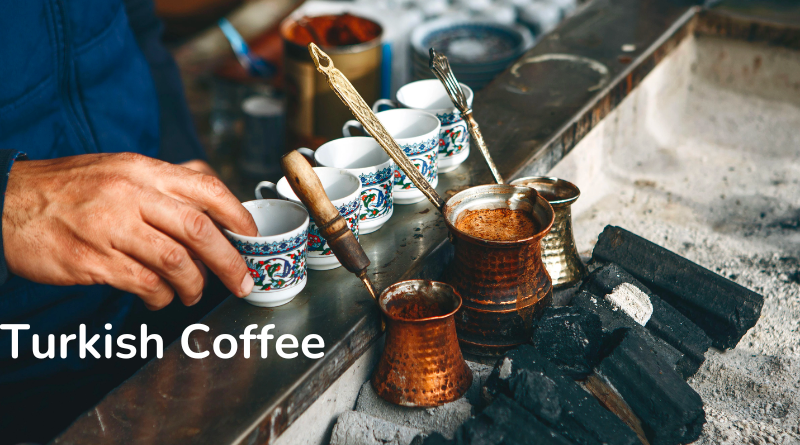Turkish Coffee – The Ultimate Guide
Turkish coffee is a popular traditional beverage that has been enjoyed for centuries in Turkey and the Middle East. Made with finely ground coffee beans and brewed in a cezve (Turkish coffee pot), Turkish coffee is known for its rich and intense flavor. In this article, we’ll explore the art of making Turkish coffee, the health benefits of this delicious beverage, and the cultural significance of Turkish coffee. Whether you’re looking for a new coffee experience or simply want to learn more about this historic beverage, read on for tips on how to make Turkish coffee at home, where to find the best “Turkish coffee near me” and more. So, grab your Turkish coffee maker, Turkish coffee cups, and Turkish coffee sand (if you’re feeling adventurous), and let’s get started!
Traditional Method of Preparing Turkish Coffee
The preparation of Turkish coffee is considered an art form, with the traditional method of preparation being handed down through generations. In this section, we will explore the traditional method of preparing Turkish coffee, using a cezve (Turkish coffee pot) and finely ground coffee beans.
Importance of Using a Cezve for Turkish Coffee

The use of a cezve is an essential component of Turkish coffee preparation. A cezve is a small, narrow, and often copper or brass coffee pot that has a long handle and a spout. The unique shape of the cezve allows for precise control over the brewing process, ensuring a consistent and flavorful cup of coffee every time. The use of copper or brass for the cezve is believed to contribute to the unique taste of Turkish coffee.
Preparing the Coffee Beans

Turkish coffee requires finely ground coffee beans, which are ground to a powder-like consistency using a special grinder. The coffee beans used for Turkish coffee are usually medium to dark roast and are typically a blend of Arabica and Robusta beans. It is essential to use fresh, high-quality coffee beans for the best taste.
Water-to-Coffee Ratio
The water-to-coffee ratio is a crucial element of Turkish coffee preparation. For a traditional cup of Turkish coffee, one tablespoon of coffee grounds is used for every three ounces of water. The ideal temperature for the water is just below boiling. Using cold water and measuring the ingredients accurately is crucial for achieving the perfect taste and consistency.
Brewing the Coffee
The brewing process for Turkish coffee requires careful monitoring and attention to detail. The cezve is heated over low to medium heat, and the coffee and water are added to the pot. The mixture is then brought to a boil and removed from heat just as it begins to froth. The process of heating and cooling the coffee is repeated two to three times to ensure a consistent and flavorful cup of coffee.
Brewing the Perfect Cup of Turkish Coffee
Turkish coffee is known for its rich, bold flavor and unique brewing process. Brewing the perfect cup of Turkish coffee requires attention to detail and a little bit of practice. In this article, we will guide you through the steps to achieve the perfect cup of Turkish coffee.
Water-to-Coffee Ratio
The water-to-coffee ratio is crucial in brewing the perfect cup of Turkish coffee. For a traditional cup of Turkish coffee, you should use one tablespoon of finely ground coffee beans for every three ounces of water. The water should be just below boiling temperature.
Using a Cezve
A cezve is a small, narrow, copper or brass coffee pot that is used to brew Turkish coffee. The shape of the cezve allows for precise control over the brewing process, ensuring a consistent and flavorful cup of coffee every time. When using a cezve, it is essential to use low to medium heat to prevent the coffee from burning.
Preparing the Coffee
Turkish coffee requires finely ground coffee beans, which are ground to a powder-like consistency using a special grinder. The coffee beans used for Turkish coffee are usually medium to dark roast and are typically a blend of Arabica and Robusta beans. It is essential to use fresh, high-quality coffee beans for the best taste.
Brewing the Coffee
The brewing process for Turkish coffee requires careful monitoring and attention to detail. The cezve is heated over low to medium heat, and the coffee and water are added to the pot. The mixture is then brought to a boil and removed from heat just as it begins to froth. The process of heating and cooling the coffee is repeated two to three times to ensure a consistent and flavorful cup of coffee.
Serving and Enjoying
Turkish coffee is traditionally served in small cups, accompanied by a glass of water and a sweet treat, such as a Turkish delight or a piece of baklava. The coffee should be served immediately after brewing to preserve its unique flavor and aroma.
Step-by-Step Guide to Making Turkish Coffee at Home
If you’re a coffee lover who wants to experience the unique taste and brewing process of Turkish coffee, then making it at home is a great option. With the right tools and ingredients, you can easily brew a delicious cup of Turkish coffee in your own kitchen. Here is a step-by-step guide to making Turkish coffee at home.
Ingredients and Tools Needed:
- Finely ground coffee beans (medium to dark roast, preferably a blend of Arabica and Robusta)
- Cold water
- Turkish coffee pot (cezve)
- Heat source (stove, hot plate, etc.)
- Sugar (optional)
Step 1: Measure the Coffee and Water
Measure one tablespoon of finely ground coffee per three ounces of cold water. For example, if you’re making two cups of coffee, you’ll need six ounces of water and two tablespoons of coffee.
Step 2: Add Coffee and Water to the Cezve
Add the coffee and water to the cezve, and stir well to combine. If you want to add sugar, this is the time to do it. Use one teaspoon of sugar per cup of coffee, or adjust to your desired level of sweetness.
Step 3: Heat the Cezve
Place the cezve over low to medium heat, and allow it to slowly heat up. Do not leave the coffee unattended, as it can quickly boil over and make a mess.
Step 4: Watch for the Froth
As the coffee heats up, you’ll start to see a layer of foam form on top. Do not stir the coffee at this point. Instead, watch for the foam to rise to the top of the cezve and remove it from the heat just as it begins to froth.
Step 5: Repeat the Process
The coffee should be heated and removed from the heat two to three times to ensure a consistent and flavorful cup of coffee. Allow the coffee to cool slightly between each round of heating and frothing.
Step 6: Serve and Enjoy
Once the coffee is ready, pour it into small cups and enjoy immediately. Turkish coffee is traditionally served with a glass of water and a sweet treat, such as a piece of baklava or Turkish delight.
Variations of Turkish Coffee
Turkish coffee is a versatile beverage that can be customized to suit different tastes and preferences. While the traditional method of making Turkish coffee involves only water and coffee, there are several variations that can be made by adding different ingredients or adjusting the brewing process. Here are some of the most popular variations of Turkish coffee.
- Sade (Plain)
The simplest and most traditional form of Turkish coffee is sade, which means plain in Turkish. This version of Turkish coffee contains only water and coffee and is typically served without sugar.
- Sekerli (Sweet)
For those with a sweet tooth, sekerli Turkish coffee is a popular variation. This version of Turkish coffee is made by adding sugar to the coffee and water mixture before heating it up. The amount of sugar can be adjusted to suit individual taste preferences.
- OrtasI (Medium Sweet)
OrtasI is a medium sweet version of Turkish coffee, which contains less sugar than sekerli but more than sade. This variation is popular among those who want a slightly sweet taste without it being too overpowering.
- Tel KadayIf (String Coffee)
Tel KadayIf, which translates to string coffee, is a unique variation of Turkish coffee that is made using a special technique. After heating the coffee and water mixture, it is removed from the heat and stirred vigorously to create a frothy texture. The froth is then spooned into small cups, and the remaining coffee is poured over it.
- Fincanda (In a Cup)
Fincanda Turkish coffee is a popular variation that is served in a small cup called a fincan. This version of Turkish coffee is typically prepared with a stronger coffee-to-water ratio than the traditional method, resulting in a bold and robust flavor.
Conclusion
In conclusion, Turkish coffee is a rich and flavorful beverage that has been enjoyed for centuries in Turkey and throughout the world. Its unique preparation method using a cezve and finely ground coffee beans, as well as its strong and bold taste, have made it a popular choice among coffee enthusiasts. By following the traditional method of brewing and using the right water-to-coffee ratio, anyone can enjoy a perfect cup of Turkish coffee at home. With various variations such as sweetened or unsweetened, and even unique ones such as string coffee, there is a Turkish coffee option for everyone. So next time you want to try something new and delicious, consider giving Turkish coffee a try.
Frequently asked questions on Turkish Coffee
- What makes Turkish coffee different from other types of coffee?
Turkish coffee is different from other types of coffee due to its unique preparation method. The coffee is ground very finely, and then simmered in a special pot called a cezve, along with water and sometimes sugar. This results in a strong, bold flavor and a thick, foamy texture.
- What type of coffee beans are used to make Turkish coffee?
The type of coffee beans used to make Turkish coffee can vary, but they are typically Arabica beans. The beans are roasted and then ground very finely, almost to a powder-like consistency.
- What is the water-to-coffee ratio for Turkish coffee?
The traditional water-to-coffee ratio for Turkish coffee is one to two teaspoons of coffee per one demitasse cup of water. However, the ratio can be adjusted to suit individual preferences.
- What is a cezve, and where can I buy one?
A cezve is a small, copper or brass pot used for brewing Turkish coffee. They can be found at specialty coffee shops or online retailers.
- Do I need a special coffee grinder to grind coffee for Turkish coffee?
Yes, to achieve the fine grind required for Turkish coffee, a special grinder called a Turkish coffee grinder is recommended. These can also be found at specialty coffee shops or online retailers.
- How do I serve Turkish coffee?
Turkish coffee is typically served in small demitasse cups. It is common to serve the coffee with a small glass of water and a sweet treat, such as Turkish delight or baklava.




